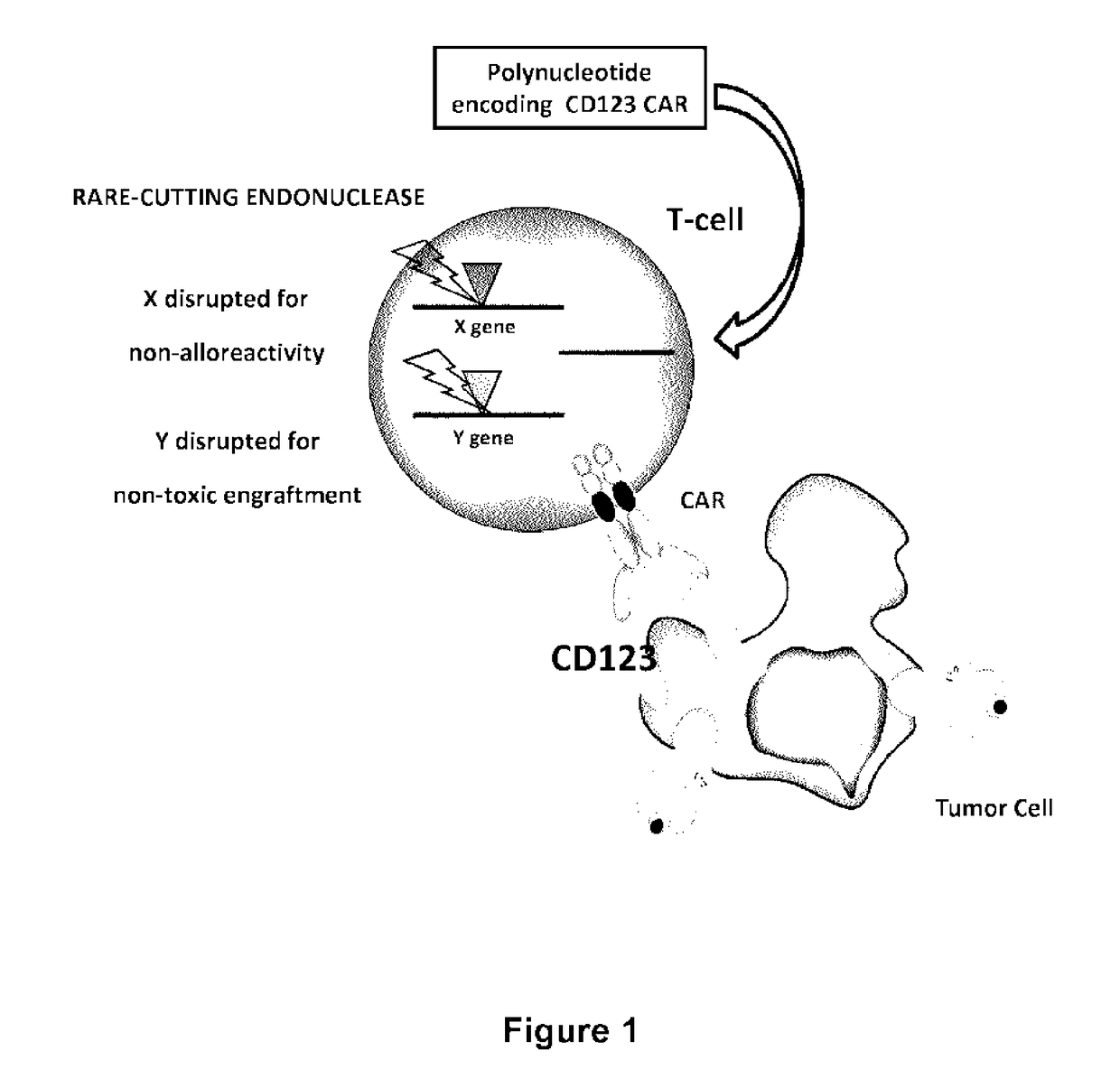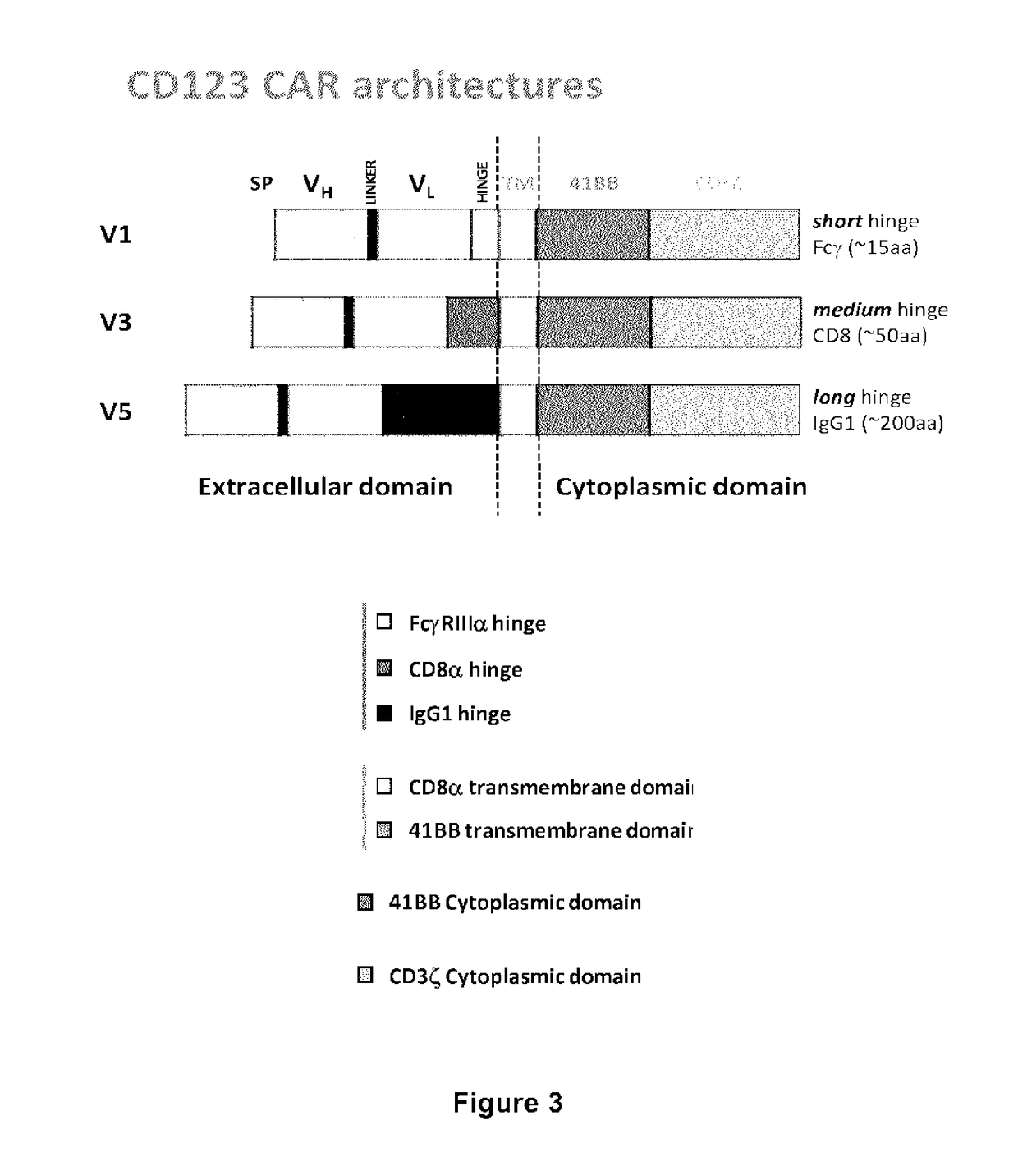CD123 specific chimeric antigen receptors for cancer immunotherapy
a chimeric antigen receptor and cancer immunotherapy technology, applied in the field of chimeric antigen receptors, can solve the problems of inability to provide prolonged expansion and anti-tumor activity in vivo, poor prognosis of aml, limited efficacy, etc., and achieve the effect of reducing the number of cancer cells
- Summary
- Abstract
- Description
- Claims
- Application Information
AI Technical Summary
Benefits of technology
Problems solved by technology
Method used
Image
Examples
example 1
tion of TCRalpha Inactivated Cells Expressing a CD123-CAR
[0433]Heterodimeric TALE-nuclease targeting two 17-bp long sequences (called half targets) separated by an 15-bp spacer within T-cell receptor alpha constant chain region (TRAC) gene were designed and produced. Each half target is recognized by repeats of the half TALE-nucleases listed in Table 10.
[0434]
TABLE 10TAL-nucleases targeting TCRalpha geneTargetTarget sequenceRepeat sequenceHalf TALE-nucleaseTRAC_T01TTGTCCCACAGATATCCRepeat TRAC_T01-LTRAC_T01-L TALENAgaaccctgaccctg(SEQ ID NO: 50)(SEQ ID NO: 52)CCGTGTACCAGCTGAGARepeat TRAC_T01-RTRAC_T01-R TALEN(SEQ ID NO: 49)(SEQ ID NO: 51)(SEQ ID NO: 53)
[0435]Each TALE-nuclease construct was subcloned using restriction enzyme digestion in a mammalian expression vector under the control of the T7 promoter. mRNA encoding TALE-nuclease cleaving TRAC genomic sequence were synthesized from plasmid carrying the coding sequence downstream from the T7 promoter.
[0436]Purified T cells preactivat...
example 2
Construction of CD123 CAR Using Various Anti-CD123 Antibody Fragments
[0439]Primary T-Cell Cultures
[0440]T cells were purified from Buffy coat samples provided by EFS (Etablissement Francais du Sang, Paris, France) using Ficoll gradient density medium (Ficoll Paque PLUS / GE Healthcare Life Sciences). The PBMC layer was recovered and T cells were purified using a commercially available T-cell enrichment kit (Stem Cell Technologies). Purified T cells were activated in X-Vivo™-15 medium (Lonza) supplemented with 20 ng / mL Human IL-2 (Miltenyi Biotech), 5% Human Serum (Sera Laboratories), and Dynabeads Human T activator CD3 / CD28 at a bead:cell ratio 1:1 (Life Technologies). After activation cells were grown and maintained in X-Vivo™-15 medium (Lonza) supplemented with 20 ng / mL Human IL-2 (Miltenyi Biotech) and 5% Human Serum (Sera Laboratories)
[0441]CAR mRNA Transfection
[0442]Transfections were done at Day 4 or Day 11 after T-cell purification and activation. 5 millions of cells were trans...
example 3
Anti-Tumor Mouse Model
[0477]Immunodefficient female NOG mice were intravenously (iv) injected with MOLM13-Luciferase cells as an AML xenograft mouse model. NOG (NOD.Cg-Prkdcscidll2rgtm1Sug / JicTac) mice, 6-8 weeks old, were obtained from Taconic (Ry, Danemark) To establish the MOLM13-Luc cell line, MOLM13 cells (DSMZ ACC 554) were transduced with a lentivirus encoding the GFP and the firefly luciferase (amsbio LVP438-PBS). The GFP-positive cells have been selected with Neomycin (ref 10131-027, Gibco, Life Technologies, Saint-Aubin, France). For information, MOLM13 cell line has been established from the peripheral blood of a 20-year-old man with acute myeloid leukemia AML FAB M5a at relapse in 1995 after initial myelodysplastic syndromes (MDS, refractory anemia with excess of blasts, RAEB).
[0478]Mice were then iv injected (either 2 or 7 days after injection of the tumor cell line) with different doses of CAR+ T-cells (Klon43-v3 CAR), or with T-cells that were not transduced with the ...
PUM
| Property | Measurement | Unit |
|---|---|---|
| temperature | aaaaa | aaaaa |
| volume | aaaaa | aaaaa |
| volume | aaaaa | aaaaa |
Abstract
Description
Claims
Application Information
 Login to View More
Login to View More - R&D
- Intellectual Property
- Life Sciences
- Materials
- Tech Scout
- Unparalleled Data Quality
- Higher Quality Content
- 60% Fewer Hallucinations
Browse by: Latest US Patents, China's latest patents, Technical Efficacy Thesaurus, Application Domain, Technology Topic, Popular Technical Reports.
© 2025 PatSnap. All rights reserved.Legal|Privacy policy|Modern Slavery Act Transparency Statement|Sitemap|About US| Contact US: help@patsnap.com



